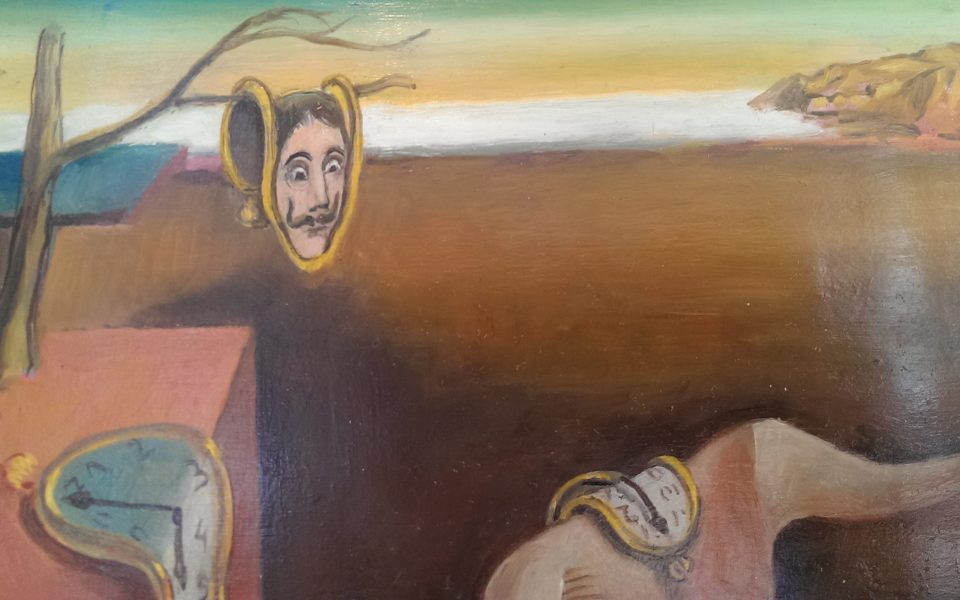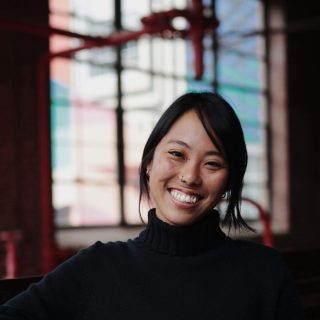by Sayaka Matsuoka
Nine small screens stacked on a wall flash with changing images. Rather than posing or depicting himself in a “rose-tinted” light, Darren Douglas Floyd took short, 20-second clips of himself over the course of 10 years, capturing both the mundane and more exciting moments of his life.
The piece, which Floyd named “There’s Nothing Wrong With Me That Hasn’t Always Been Wrong With Me,” is part of Greenhill’s latest dual exhibition, Fritz Janschka’s Portrait Museum and Self-Portraits by NC Artists, which explores the relationship between the artist and their most personal subject: themselves.
As soon as viewers walk into the Greensboro gallery, they’re met with sunken, brick eyes. “Brad in Brick” by Brad Spenser sits on a gallery pedestal and greets visitors as they enter the first half of the exhibition space that highlights the self-portraits of North Carolina artists. On the left wall past the brick bust is a large close-up profile painted portrait measuring by Saba Barnard titled “Self.” Next to it is an equally sized QR code painted onto a canvas titled “Self.jpg.” On the text accompanying the work, Barnard invites viewers to scan the code to access another one of her self-portraits, merging visual art with technology. That intertwining of old, familiar methods of self-portrayal with newer, technological methods is what makes this exhibition extraordinary.
The more indirect, technological pieces by Mark Nystrom include an interactive computer which measures the environmental carbon-footprint of users, and a second desktop with a cloud of words created randomly on repeat from the text of Nystrom’s saved email messages.
Other more traditional forms of self-portraiture also make up the exhibition, from paintings on canvas to sculptures made of wood, wire or glass as well as black-and-white photography. Greensboro artist and UNCG photography professor Leah Sobsey displays photographs of herself on a reflective surface called kodalith, engaging viewers as their own reflections appear cast on top of Sobsey’s, creating a dual portrait.
Another photographer, Elizabeth Matheson, captivates viewers with themes of mortality using photos of herself at 27 and again at 72, wearing the same dress and striking the same pose. The photo evokes a sense of dread, and is simultaneously eerie and poignant.
The exhibition ranges in theme and style with bold, colorful pieces filling the same space as more morbid, quiet ones.
And that is one of its core strengths.
One of the most arresting and thought-provoking paintings in the exhibition is Steven Cozart’s “Judgments.” In his piece, the black artist sits in the center of the painting with an open gesture that allures viewers in without being too overbearing, his gaze cast downwards away from viewers. Above him is a grayscale with a white center. Cozart’s piece urges spectators to question issues about race and the ways in which people judge others. His non-confrontational pose and his inverted grayscale show that initial reactions or stereotypes about people based on skin color are not always correct. He probes viewers to see past surface appearances.
Other artists took a more whimsical approach, like Richard Stenhouse’s drawings of himself as a cockroach in one frame and a tortilla in another. Beyond his pieces, towards the back of the gallery, begins the other half of the exhibition, Fritz Janschka’s Portrait Museum.
This portion of the gallery only houses works by Janschka, whose style is strikingly different than the first half of the exhibition. They are sketchy and colorful, reminding viewers of Picasso’s style. Many of his sketches, paintings and sculptures depict famous artists such as Hopper, Chagall, Pollock and Kahlo in amusing and cheeky contexts with personalized quotes beneath each one. Mona Lisa sits in her familiar landscape but as a nude. Frida Kahlo’s face appears superimposed on the body of an injured deer. Dalí hangs from a tree as one of his own melting clocks.
Janschka’s paintings may be provocative but they are also masterful. The artist took great pains to carefully emulate each artist’s style, enticing viewers on a visual voyage through art history. He even paints his old professor who taught him to “learn from the masters.”
As Edie Carpenter, the exhibition’s curator explained, “His portraits poke fun but are true homages to each of the artists involved.”
Many times, Janschka paints himself in the paintings alongside the masters.
“It’s interesting to see how artists depict their relationships with themselves,” Carpenter said.
The ways in which artists choose to portray themselves is vastly different throughout the exhibition. What they highlight and what they leave out ultimately end up defining themselves.
Many artists in the gallery show themselves in their element, painting or sketching while others are defined by their relationships. And still others probe the question of how their identities are mediated by technology. Some use glass while others use watercolor. One self-portrait is carved into a wooden bar tap handle.
Whether it’s honest, straightforward depictions or amusing works that mock the artists, the dual exhibition at Greenhill offers a wide range of self-portraits. They even inviting viewers to reflect on themselves by taking selfies to be displayed in the gallery throughout the course of the exhibition.
Join the First Amendment Society, a membership that goes directly to funding TCB‘s newsroom.
We believe that reporting can save the world.
The TCB First Amendment Society recognizes the vital role of a free, unfettered press with a bundling of local experiences designed to build community, and unique engagements with our newsroom that will help you understand, and shape, local journalism’s critical role in uplifting the people in our cities.
All revenue goes directly into the newsroom as reporters’ salaries and freelance commissions.


Leave a Reply